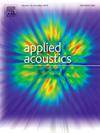利用点质量改善板式吸声器的低频吸声性能
IF 3.4
2区 物理与天体物理
Q1 ACOUSTICS
引用次数: 0
摘要
吸声是管理房间和办公室噪音的重要工具。与多孔材料和纤维板不同,面板吸收器可以有效地吸收低频,应用深度较浅,而多孔材料和纤维板需要厚而笨重的设计来实现低频性能。然而,面板吸收器通常在一个狭窄的频率范围内是成功的。本研究致力于评估附在面板上的点质量面板吸声器在有效外形因素下的宽带低频吸声效果。通过详细的数值分析,得到了当添加点质量的位置和数量发生变化时,面板吸声的振声响应。实验研究了附加点质量对板式吸声器吸声特性的影响。结果表明,利用内部设计元素和小质量设计面板吸收器可以降低200 Hz以下多个频率的噪声。本文章由计算机程序翻译,如有差异,请以英文原文为准。
Improving low frequency sound absorption of panel absorbers using point mass
Sound absorption is an essential tool for managing noise in rooms and offices. Panel absorbers can be effective for low-frequency absorption with shallow application depths, unlike porous materials and fibrous panels, which requiring thick and bulky designs for low frequency performance. Nevertheless, panel absorbers are generally successful in a single narrow frequency range. This study is devoted to evaluating panel absorbers with point mass attached to the panel for broad band low frequency sound absorption in an effective form factor. Detailed numerical analyses were performed to obtain the vibro-acoustic response of the panel absorbers while varying the position and amount of the added point mass. The effect of the added point mass on the sound absorption characteristics of the plate absorbers was experimentally investigated. The results revealed that it is possible to design panel absorbers using interior design elements and small masses to reduce the noise in multiple frequencies below 200 Hz.
求助全文
通过发布文献求助,成功后即可免费获取论文全文。
去求助
来源期刊

Applied Acoustics
物理-声学
CiteScore
7.40
自引率
11.80%
发文量
618
审稿时长
7.5 months
期刊介绍:
Since its launch in 1968, Applied Acoustics has been publishing high quality research papers providing state-of-the-art coverage of research findings for engineers and scientists involved in applications of acoustics in the widest sense.
Applied Acoustics looks not only at recent developments in the understanding of acoustics but also at ways of exploiting that understanding. The Journal aims to encourage the exchange of practical experience through publication and in so doing creates a fund of technological information that can be used for solving related problems. The presentation of information in graphical or tabular form is especially encouraged. If a report of a mathematical development is a necessary part of a paper it is important to ensure that it is there only as an integral part of a practical solution to a problem and is supported by data. Applied Acoustics encourages the exchange of practical experience in the following ways: • Complete Papers • Short Technical Notes • Review Articles; and thereby provides a wealth of technological information that can be used to solve related problems.
Manuscripts that address all fields of applications of acoustics ranging from medicine and NDT to the environment and buildings are welcome.
 求助内容:
求助内容: 应助结果提醒方式:
应助结果提醒方式:


